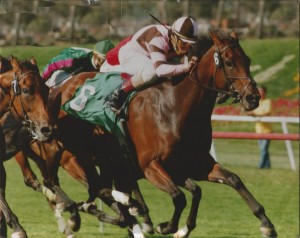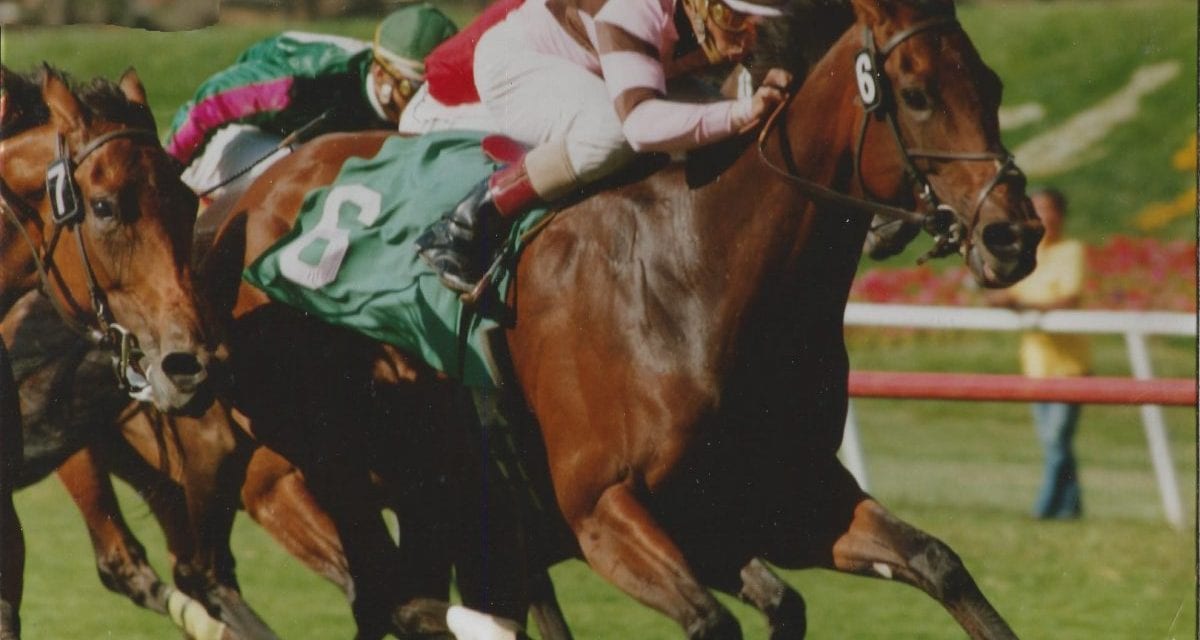by George Rowand[boxify cols_use =”2″ cols =”5″ position =”right” order =”none” box_spacing =”5″ padding =”3″ background_color =”gray” background_opacity =”10″ border_width =”1″ border_color =”blue” border_style =”solid” height =”200″ ]LESSONS LEARNED
- Know your mare.
- Don’t expect lightning to strike twice.
- Breed type to type in size and stamina.
- Don’t worry about Nick.
[/boxify]
At the same time that Highland Mills was producing great foals, we were also breeding two other mares. However, they weren’t working out as well.
We had bought Toujours L’Audace and Fragile Dream as yearlings. Neither went to the races, so what I could glean about their strengths and weaknesses came from what other members of their families had done. I found a hodge-podge of influences in their pedigrees.
Toujours L’Audace (by Intrepid Hero out of Vapors, by Swoons Son) was out of an older mare that had produced dirt sprinters, including one that was stakes-placed. The person that bred her, however, decided to go in the opposite direction. He bred her dam to Intrepid Hero, a horse that was most effective at a mile-and-a-half on the grass.
Fragile Dream, on the other hand, was by Turn And Count, a stallion that was about 17 hands. She was out of Silent Choice (by Silent Screen), a mare that was about 15 hands. I suppose her breeder had wanted to put some size into the foal, and he did. But she didn’t make it to the races, and I suspect part of the reason was because her body parts just didn’t fit together too well.
Those experiences led me to affirm an opinion held by many others, and it is point 3: Breed type to type.
If your mare was a sprinter, breed her to sprinting stallions. If your mare ran a distance, breed her to a stallion that has stamina in his pedigree. Whatever size your mare is, try to breed to stallions that are close to that size. I never bred Highland Mills to any stallion that was more than one hand different in size from her.
Who’s Nick?

Miss Josh, out of Highland Mills, wins the Grade 1 Gamely Handicap. Photo courtesy of George Rowand.
If there was one thing about which we were certain when we bought Highland Mills, it was that Pia Star mares like her nicked well with Bold Ruler-line stallions. We followed the statistical advice and bred to the Bold Ruler line twice, once to Spectacular Bid and the other to Seattle Slew. We got two unsuccessful foals. The Bid colt actually won $75,000, but it took him three years to do that, and that was a losing proposition.
As for Seattle Slew, well, I was never too keen to breed to him. By the time we did, it was clear that our mare was producing turf horses, and Slew was a dirt sire. But a half-sister to Highland Mills by Slew had become a graded stakes winner of over $400,000, so we gave it a try. What we got was a colt that looked good as a yearling, better at 2, and then proceeded to become the least attractive horse we ever bred. He ended up winning one cheap maiden claimer and less than $5,000 in his racing career. So where is the nick that was supposed to be so potent? That’s point 4.
The problem with the idea of a breeding nick in the first place is that the sample sizes are tiny. You might have two good horses by a certain stallion and out of broodmares by a certain other stallion that skew the statistics completely. And besides, the broodmare sire is only 50 percent of the mare’s equation. What about the other half? Doesn’t that count? So, for me, the concept of breeding nicks just doesn’t resonate.
We were unsuccessful breeding either Fragile Dream or Toujours L’Audace. I knew it wasn’t going to work with Toujours L’Audace after I bred her to a stallion that would give the resulting foal a 3X3 inbreeding to full-brother and full-sister. In other circumstances, this might have been a home run, but with her, it produced the only foal we ever bred that didn’t win at least one race. He made it to the track, as did all the horses that we bred, but he didn’t win, and he should have.
Fragile Dream produced two winners for us, but they had marginal careers, and if there is one thing that a small owner-breeder cannot afford, it’s a marginal horse. We sold both her and Toujours L’Audace.
All in all, we had some success, and we had some failure. We learned some lessons along the way, which I’ve summed up above. But the main thing is: I’ve always believed that there’s a perfect stallion for every mare. It’s the job of the breeder to find that stallion.








